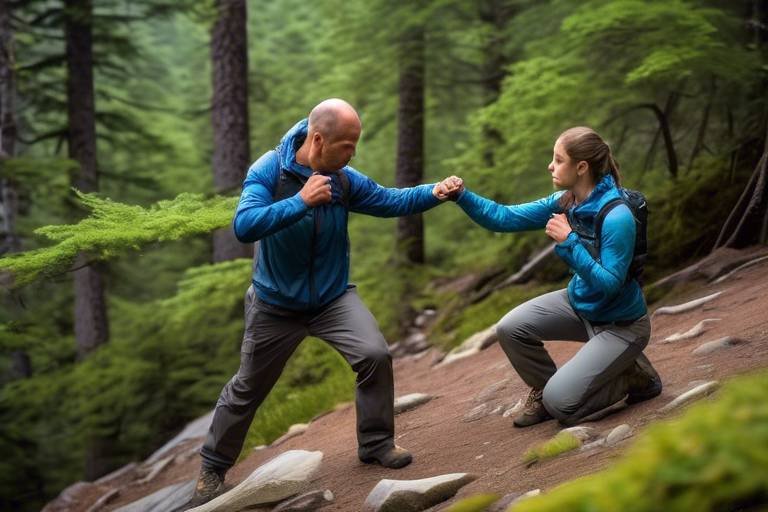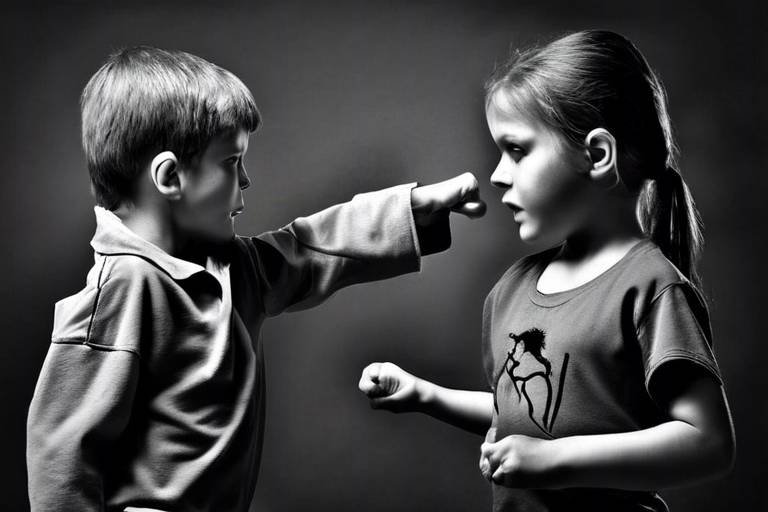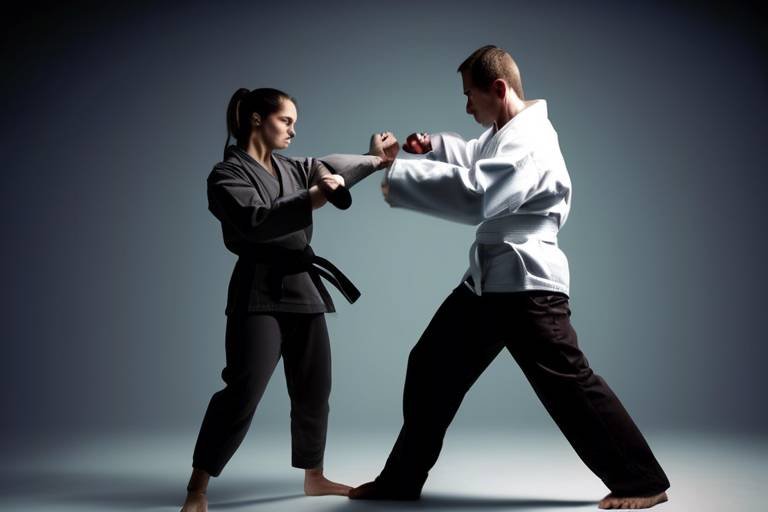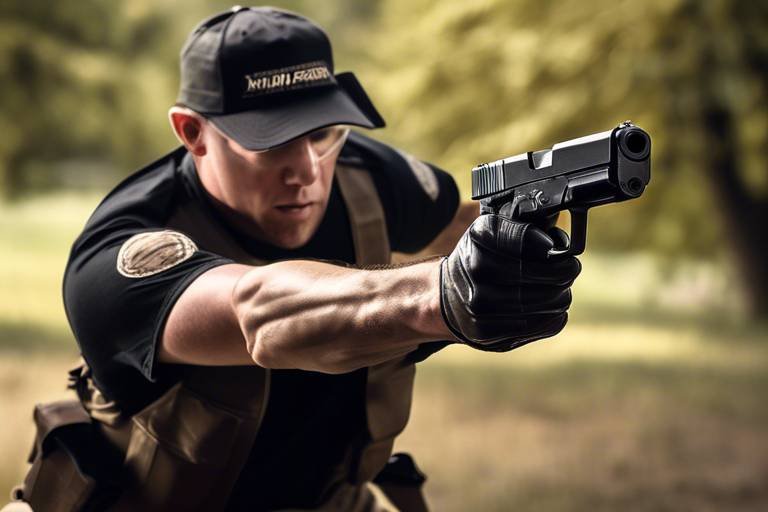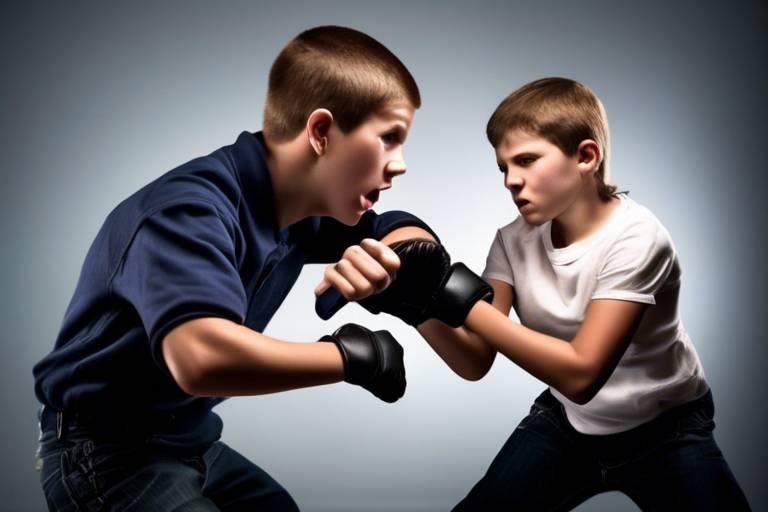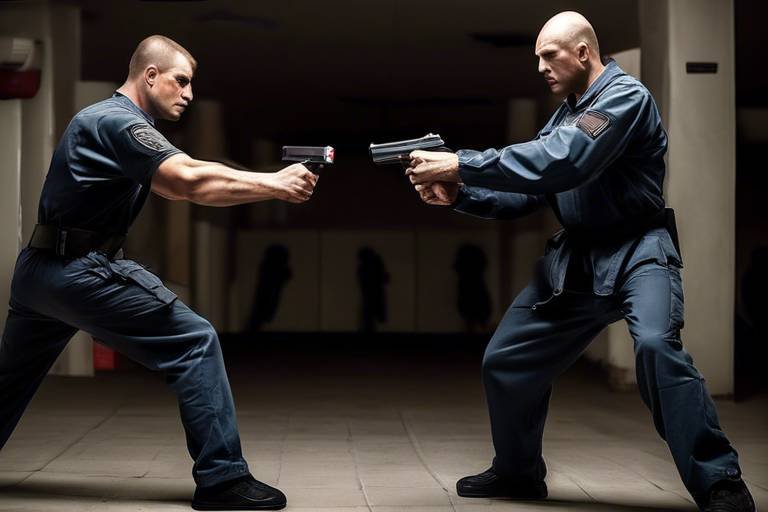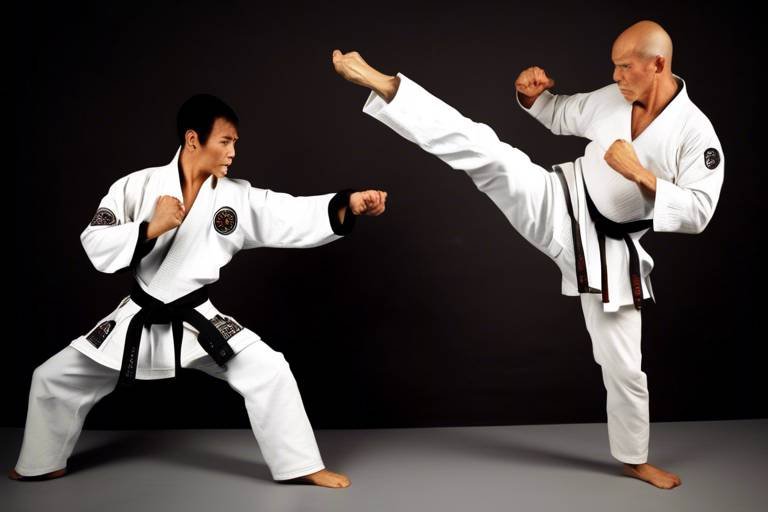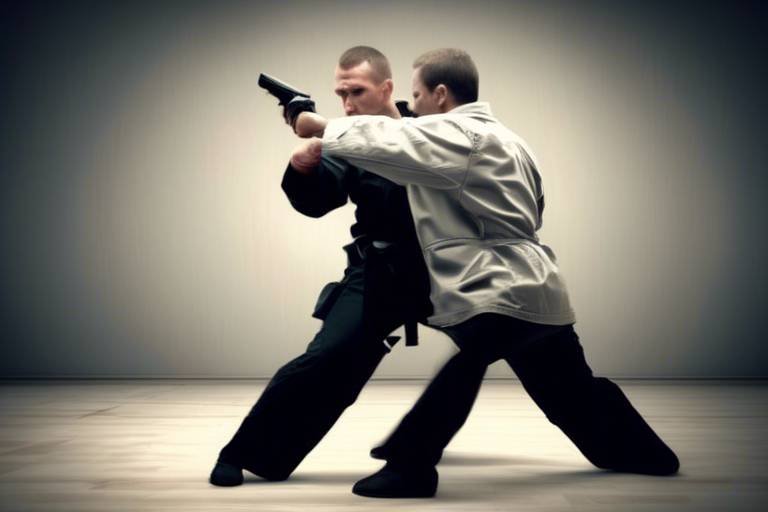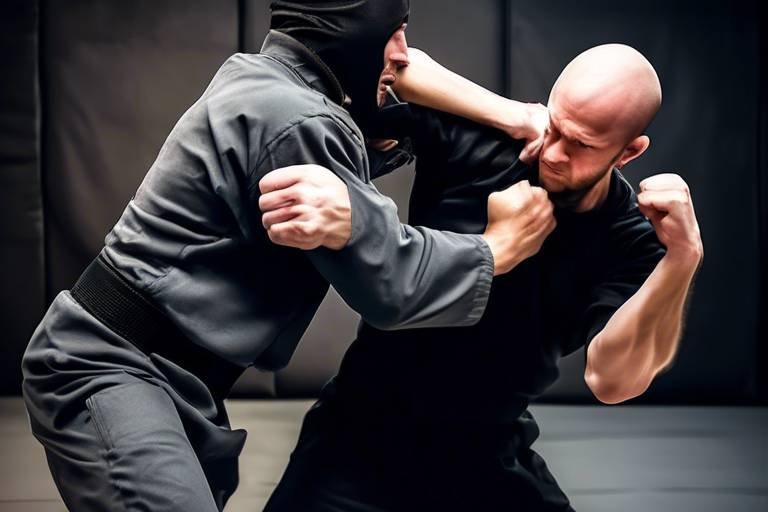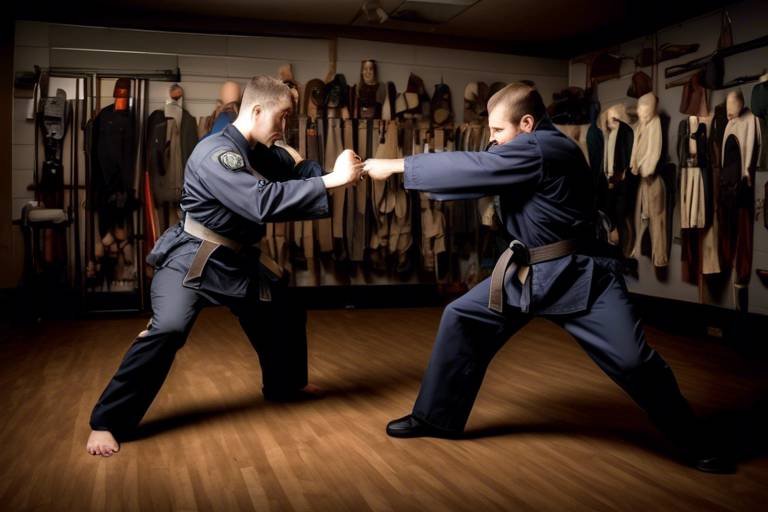How to Implement Moves from Karate into Your Self-Defense Training?
Have you ever wondered how the graceful yet powerful moves of karate can be transformed into practical self-defense techniques? Integrating karate into your self-defense training is not just about learning how to throw a punch or kick; it’s about understanding the underlying principles that make these techniques effective. In this article, we will explore the seamless transition of karate techniques into self-defense, highlighting the practical applications, benefits, and essential training methods that can significantly enhance your personal safety and combat readiness.
Before diving into the specific techniques, it’s crucial to grasp the foundational elements of karate. Think of karate as the bedrock upon which your self-defense skills will be built. The primary components include stances, strikes, and blocks. Mastering these basics is like learning the alphabet before writing a novel; without them, your self-defense skills may lack clarity and effectiveness. Stances provide stability, strikes deliver power, and blocks offer protection. When you can execute these elements with precision, you create a solid framework for real-life applications.
Now that we've laid the groundwork, let's delve into the specific karate techniques that can be applied in self-defense situations. These techniques include punches, kicks, and joint locks, each with unique advantages against various threats. For instance, a well-timed punch can incapacitate an attacker, while a swift kick can create the distance needed to escape a dangerous situation. Joint locks, on the other hand, focus on controlling your opponent, allowing you to neutralize a threat without relying solely on brute strength. Understanding these techniques is essential for anyone looking to enhance their self-defense capabilities.
Striking techniques are among the most effective tools in karate that can be adapted for self-defense. Let's take a closer look at some of these techniques:
- Jabs: Quick and direct, jabs can be used to gauge distance and create openings.
- Crosses: A powerful strike that can deliver significant impact, especially when aimed at vulnerable areas.
- Roundhouse Kicks: These kicks are not only visually impressive but also effective for targeting an attacker's head or body.
By practicing these striking techniques, you can develop the ability to defend yourself effectively while maintaining control of the situation.
In the world of self-defense, being proactive is essential, but so is knowing how to defend yourself against incoming attacks. Defensive maneuvers such as blocks and parries are critical skills that every practitioner should master. Blocks can absorb the force of an attack, while parries redirect the attacker's energy, allowing you to counterattack effectively. Imagine these maneuvers as your shield and sword in a battle; they protect you while also giving you the opportunity to strike back.
Joint locks and throws are techniques that leverage biomechanics to control or subdue an opponent. These moves are particularly advantageous for individuals who may not possess the physical strength to overpower an attacker. By focusing on technique and leverage, you can effectively neutralize a threat without excessive force. Picture these techniques as a dance; with the right moves, you can lead your opponent where you want them to go, ultimately gaining the upper hand.
To maximize the effectiveness of your self-defense training, it’s essential to learn how to combine various karate techniques into a cohesive strategy. This means not only practicing individual moves but also integrating them into drills that simulate real-world scenarios. For example, you might practice a sequence that starts with a defensive block, transitions into a strike, and finishes with a joint lock. This holistic approach prepares you for the unpredictability of real-life confrontations.
Beyond the physical techniques, incorporating karate into your self-defense training offers valuable psychological benefits. As you learn and practice these techniques, you’ll notice a significant boost in your confidence, awareness, and mental resilience. Confidence is key in a self-defense situation; it empowers you to react decisively and assertively. Think of your training as a mental armor that prepares you for the unexpected, enhancing not only your skills but also your mindset.
Developing a consistent training routine is vital for integrating karate moves into your self-defense practice. Your routine should focus on skill development, physical conditioning, and situational awareness. Consider setting aside specific times each week to practice techniques, engage in conditioning exercises, and simulate potential scenarios. By committing to a routine, you’ll build muscle memory, which is crucial for executing techniques under pressure.
Training with a partner can significantly enhance your self-defense skills. A partner allows you to simulate real-life scenarios, providing opportunities for practice and feedback. When choosing a training partner, look for someone who is committed to mutual improvement and safety. This collaboration not only makes training more enjoyable but also helps you to refine your techniques in a controlled environment.
Q: Can anyone learn karate for self-defense?
A: Absolutely! Karate techniques can be adapted for individuals of all skill levels and physical abilities.
Q: How long does it take to see results from training?
A: Results vary, but with consistent practice, many individuals notice improvements in their skills and confidence within a few months.
Q: Is it safe to practice karate techniques for self-defense?
A: Yes, as long as proper safety measures are taken and training is conducted in a controlled environment.

Understanding Karate Basics
When diving into the world of karate, it's essential to grasp the foundational principles that underpin this martial art. Think of karate as a well-structured building; without a solid foundation, everything else can come crumbling down. The basics of karate consist of various stances, strikes, and blocks, each serving a crucial role in effective self-defense. Mastering these elements is not just about learning how to throw a punch or kick; it’s about building muscle memory and confidence that can be called upon in real-life situations.
Let’s break down some of the key components:
- Stances: The starting point for any technique. A strong stance provides balance and stability, allowing you to execute moves with power and precision. Common stances include the front stance (zenkutsu-dachi) and horse stance (kiba-dachi).
- Strikes: These are the offensive moves in karate, including punches (tsuki) and kicks (geri). Each strike has its own mechanics and purpose, whether it’s to incapacitate an attacker or create distance.
- Blocks: Defensive techniques that help protect against incoming attacks. Learning how to block effectively can mean the difference between safety and injury in a self-defense scenario.
Understanding these basics is crucial before applying them in real-life situations. Each technique is designed to flow into the next, creating a seamless defense strategy. For example, if you throw a punch and your opponent counters, a well-timed block can redirect their force while setting you up for a counter-attack. This fluidity is what makes karate not just a series of movements but a dynamic art form that adapts to the situation at hand.
Moreover, the practice of kata, or forms, is instrumental in reinforcing these basics. Kata allows practitioners to drill their movements in a controlled environment, ingraining the techniques into muscle memory. It’s like rehearsing for a play; the more you practice, the more natural it becomes. Each kata has its own set of movements that simulate combat scenarios, providing a mental and physical blueprint for real-life application.
In summary, understanding the basics of karate is more than just memorizing techniques; it’s about developing a mindset and physicality that can be effectively utilized in self-defense. As you progress, you’ll find that these fundamentals serve as the bedrock upon which more advanced techniques are built, ultimately enhancing your ability to protect yourself and others.

Key Karate Techniques for Self-Defense
When it comes to self-defense, having a solid grasp of karate techniques can be a game changer. These techniques are not just about throwing punches or kicks; they embody a philosophy of movement and awareness that can empower you in real-life situations. Let's dive into some of the most effective techniques that can be seamlessly integrated into your self-defense arsenal.
One of the cornerstones of karate is the ability to strike effectively. Techniques such as punches, kicks, and joint locks can be utilized in various self-defense scenarios. For instance, a well-executed jab can create the necessary distance between you and an aggressor, giving you a moment to assess your next move. Similarly, a powerful roundhouse kick can incapacitate an attacker, allowing you to escape. The beauty of these techniques lies in their adaptability; they can be modified for different situations, whether you're facing one or multiple attackers.
Striking techniques are your first line of defense. They include:
- Jabs: Quick and effective for maintaining distance.
- Crosses: Powerful strikes that can deliver significant impact.
- Roundhouse Kicks: Excellent for targeting an opponent's head or torso.
Each of these strikes serves a unique purpose. For example, the jab can be used to gauge distance and keep an attacker at bay, while the roundhouse kick can be a decisive blow that quickly ends a confrontation. It's essential to practice these strikes until they become second nature, allowing you to react instinctively in high-pressure situations.
Now, let’s talk about the importance of defensive maneuvers. Techniques such as blocks and parries are crucial for protecting yourself from incoming attacks. Imagine you're facing an opponent who throws a punch; if you're able to block or deflect that punch, you not only protect yourself but also create an opening for your counterattack. Mastering these defensive techniques is vital, as they enable you to stay safe while waiting for the right moment to strike back.
Joint locks and throws are often overlooked but can be incredibly effective in self-defense. These techniques focus on using leverage and body mechanics rather than brute strength, making them accessible to anyone, regardless of size or physical strength. For example, a simple wrist lock can immobilize an attacker, allowing you to escape or control the situation. Throws can also be utilized to take an opponent down, giving you the upper hand in a confrontation.
Incorporating these techniques into your training routine can significantly enhance your self-defense skills. It's not just about learning how to punch or kick; it's about understanding the principles behind each movement and how they can be applied in real-world scenarios. Regular practice will help you internalize these techniques, making them instinctive when you need them most.
Combining various karate techniques into a cohesive self-defense strategy is essential. Imagine a scenario where you might need to block an attack, counter with a strike, and then apply a joint lock to control the situation. By practicing drills that incorporate these movements, you can develop a seamless flow that prepares you for unpredictable encounters. Remember, the goal is not just to learn techniques but to create a response system that feels natural and effective.
Q: Can I learn these techniques without prior karate experience?
A: Absolutely! Many self-defense classes are designed for beginners and will teach you the fundamentals.
Q: How often should I practice these techniques?
A: Consistency is key. Aim for at least two to three practice sessions per week to build muscle memory.
Q: Are these techniques effective against larger opponents?
A: Yes! Karate techniques often rely on timing and technique rather than brute strength, making them effective for anyone.

Striking Techniques
When it comes to self-defense, from karate can be your best friend. Imagine being in a situation where you need to defend yourself—what would you do? The ability to deliver effective strikes can create the necessary distance between you and an attacker, giving you a chance to escape or gain control of the situation. Striking in karate is not just about strength; it's about precision, timing, and technique. Let's break down some of the most effective striking techniques that can be seamlessly integrated into your self-defense training.
First up, we have the jab. This technique is often underestimated but can be incredibly powerful. The jab is a quick, straight punch thrown with your lead hand, designed to keep an opponent at bay. Think of it as a way to measure distance while delivering a quick strike. It’s like throwing a stone into a pond; the ripples created can distract your opponent and give you the edge you need to follow up with a more powerful strike.
Next is the cross, which is a powerful punch thrown with your rear hand. It’s often used in combination with the jab to create a one-two punch that can catch an attacker off guard. The cross is all about utilizing your body weight and rotation to generate force. When executed correctly, it can be a game-changer in a self-defense scenario.
Now, let’s not forget about the roundhouse kick. This kick is a staple in karate and can be devastating when used correctly. Picture a door swinging open; that’s the motion of a roundhouse kick. By pivoting on your supporting foot and swinging your leg in a circular motion, you can strike an opponent with the shin or instep, which can incapacitate them momentarily. It’s all about creating that surprise element—catching them off guard and making your escape.
Incorporating these striking techniques into your self-defense training can be incredibly beneficial. Here’s a quick overview of how these techniques can be applied:
| Technique | Description | Application |
|---|---|---|
| Jab | A quick, straight punch with the lead hand. | Used to maintain distance and distract the attacker. |
| Cross | A powerful punch with the rear hand. | Used in combination with the jab for maximum impact. |
| Roundhouse Kick | A circular kick that targets the opponent’s head or body. | Used to create distance and incapacitate the attacker. |
Remember, the effectiveness of these strikes lies not only in their execution but also in your ability to remain calm and focused during a confrontation. Practicing these techniques regularly will help you develop muscle memory, making it easier to respond instinctively when the need arises. So, get out there and start practicing! Your safety may depend on it.

Defensive Maneuvers
When it comes to self-defense, the ability to protect oneself from incoming attacks is paramount. This is where come into play. Think of them as your personal shield, designed to absorb and deflect the force of an attack while giving you the opportunity to counter. In karate, mastering these techniques is not just about physical strength; it’s about timing, precision, and mental acuity. By understanding and practicing these defensive moves, you can significantly enhance your chances of escaping a potentially dangerous situation.
One of the most fundamental defensive techniques in karate is the block. Blocks are designed to intercept an opponent's strikes, allowing you to protect vital areas of your body. There are various types of blocks, including the high block, low block, and middle block, each serving a specific purpose. For instance, a high block can protect your head from an overhead strike, while a low block can guard against kicks aimed at your lower body. To effectively execute a block, it’s essential to maintain proper stance and body alignment, ensuring that your movements are both fluid and powerful.
Another critical aspect of defensive maneuvers is the parry. Unlike a block, which stops an attack, a parry redirects it. This technique requires a keen sense of timing and spatial awareness, as you must anticipate your opponent’s movements. For example, if someone throws a punch, a well-timed parry can deflect their hand away from your face, creating an opening for you to counterattack. This is where the beauty of karate shines—it's not just about defense; it's about turning the tables on your attacker.
In addition to blocks and parries, incorporating footwork into your defensive strategy is crucial. Good footwork allows you to create distance from an attacker, making it harder for them to land a hit. By practicing lateral movements and quick pivots, you can evade attacks while positioning yourself for a counter-strike. Remember, the goal of defensive maneuvers is not only to protect yourself but also to seize the moment and regain control of the situation.
To illustrate the effectiveness of these defensive techniques, consider the following table that outlines the key differences between blocks and parries:
| Technique | Purpose | Execution | Counter-Attack Potential |
|---|---|---|---|
| Block | To stop an incoming attack | Directly intercepts the strike | Limited; usually follows with a defensive move |
| Parry | To redirect an attack | Deflects the strike away | High; creates openings for counterattacks |
In conclusion, mastering defensive maneuvers is essential for anyone looking to integrate karate into their self-defense training. By focusing on blocks, parries, and effective footwork, you can build a robust defense that not only protects but also empowers you to take action. Remember, the best defense is a good offense, and with practice, you’ll be able to handle a variety of situations with confidence and skill.
- What is the difference between a block and a parry? A block stops an incoming attack, while a parry redirects it.
- How important is footwork in defensive maneuvers? Footwork is crucial as it allows you to evade attacks and position yourself for a counter.
- Can anyone learn these techniques? Yes! With practice and dedication, anyone can learn and effectively apply these defensive maneuvers.

Joint Locks and Throws
When it comes to self-defense, understanding joint locks and throws can be a game-changer. These techniques are not just about brute strength; they rely on leverage, timing, and technique. Imagine being in a situation where someone is trying to overpower you. Instead of relying on sheer muscle, you can use their own force against them. Joint locks, for instance, can immobilize an attacker by targeting vulnerable points in their joints, like the wrists, elbows, or shoulders. This not only provides a way to control the situation but also minimizes the risk of injury to yourself.
Joint locks can be particularly effective because they allow a defender to subdue an opponent without causing excessive harm. They work by applying pressure to a joint, which can lead to pain or even incapacitation if executed properly. For example, a common joint lock is the wrist lock, where you can twist an assailant's wrist to gain control over them. This technique is not only effective but also relatively easy to learn, making it accessible for individuals of all sizes and strengths.
Throws, on the other hand, are about using your body weight and the opponent's momentum to your advantage. Think of a judo throw: you don't need to be the strongest person in the room to throw someone twice your size. Instead, you utilize their movement against them. For instance, when someone charges at you, a well-timed throw can redirect their energy, sending them tumbling to the ground. This can create an opportunity for you to escape or gain control of the situation.
Incorporating these techniques into your self-defense training can greatly enhance your effectiveness in real-life scenarios. Here are some key points to remember when practicing joint locks and throws:
- Practice with a partner: This allows you to understand the mechanics and feel the pressure involved in these techniques.
- Focus on technique over strength: Mastering the mechanics will enable you to execute these moves even against larger opponents.
- Be aware of your surroundings: Knowing when and where to apply these techniques is crucial for effective self-defense.
In conclusion, joint locks and throws are essential components of a well-rounded self-defense strategy. They not only empower you to defend yourself effectively but also instill a sense of confidence in your ability to handle dangerous situations. By mastering these techniques, you are investing in your personal safety and well-being.
Q: Are joint locks and throws safe to practice?
A: Yes, when practiced under the supervision of a qualified instructor and with a willing partner, these techniques can be safe and effective.
Q: Can anyone learn joint locks and throws?
A: Absolutely! These techniques are designed to be accessible to individuals of all sizes and strengths, making them ideal for self-defense training.
Q: How long does it take to learn these techniques?
A: The time it takes to learn joint locks and throws varies by individual, but consistent practice can lead to proficiency in a matter of weeks.

Combining Techniques for Real-World Application
When it comes to self-defense, simply knowing a few karate moves isn’t enough. The real magic happens when you combine techniques into a fluid, adaptable strategy that can respond to various situations. Think of it like being a chef: you can have the best ingredients, but if you don’t know how to mix them, the dish won’t taste great. In self-defense, your 'ingredients' are the karate techniques you’ve learned, and your 'dish' is how you apply them in real life.
To effectively combine karate techniques, you need to understand how they can work together. For instance, a strong punch can be followed by a swift kick, or a block can transition into a counter-attack. Imagine you’re in a situation where an attacker approaches you. You might begin with a defensive stance to assess the threat, then use a block to deflect their initial strike. From there, you can execute a jab to create distance, followed by a roundhouse kick to incapacitate them. This sequence not only showcases your skill but also keeps you one step ahead.
One effective way to practice combining techniques is through drills. Set up scenarios with a partner where you can practice responding to different types of attacks. For example, you could work on a drill where your partner throws a punch at you, and your job is to block it, then counter with a punch of your own, followed by a kick. This not only helps you develop muscle memory but also builds your confidence in executing these moves under pressure.
Additionally, consider incorporating real-world scenarios into your training. You might simulate an attack from behind, allowing you to practice your reaction time and adaptability. Remember, the goal is to be versatile. You can create a simple table to track your progress with different combinations:
| Technique Combination | Effectiveness Rating (1-10) | Notes |
|---|---|---|
| Block + Jab + Kick | 8 | Great for creating distance |
| Parry + Elbow Strike + Knee | 9 | Effective in close quarters |
| Joint Lock + Throw | 7 | Requires precise timing |
As you work on combining these techniques, always keep your mind open to adjustments and improvements. Just like any great athlete, the ability to adapt and evolve is crucial. Your training should reflect the unpredictability of real-life situations, so be prepared to modify your approach based on what you encounter.
In conclusion, combining karate techniques for self-defense isn’t just about memorizing moves; it’s about creating a cohesive strategy that allows you to respond effectively to threats. By practicing regularly, incorporating drills, and simulating real-world scenarios, you can enhance your self-defense capabilities and feel more confident in your ability to protect yourself.
- Can anyone learn karate for self-defense? Absolutely! Karate is accessible to individuals of all skill levels.
- How long does it take to become proficient in karate techniques? Proficiency varies by individual, but consistent practice can lead to noticeable improvements within a few months.
- Is it necessary to spar with a partner? While not mandatory, sparring can significantly enhance your ability to apply techniques in real situations.

Building Confidence Through Training
When it comes to self-defense, confidence is your best ally. Imagine walking down the street, feeling like you could take on anything that comes your way. This isn’t just a pipe dream; it’s a reality you can create through consistent karate training. By integrating karate techniques into your self-defense practice, you not only learn how to defend yourself but also cultivate a strong sense of self-assurance that translates into every aspect of your life. The beauty of karate lies in its structured approach to personal safety, teaching you more than just physical moves. It instills a mindset of resilience and awareness that can make all the difference in a tense situation.
One of the most significant benefits of karate training is the psychological boost it provides. As you practice various techniques, you begin to understand your body and its capabilities. This awareness fosters a sense of empowerment. You learn to trust your instincts, react swiftly, and make decisions under pressure. This newfound confidence can be likened to a shield; it protects you not only in physical confrontations but also in everyday interactions. Whether you are negotiating a tough situation at work or standing your ground in social settings, the assertiveness gained from training can be invaluable.
Moreover, the community aspect of karate training cannot be overlooked. Engaging with fellow practitioners creates a supportive environment where you can share experiences, challenges, and victories. This camaraderie enhances your learning experience and reinforces your confidence. You’re not just learning to fight; you’re building relationships that help you grow as a person. The encouragement from peers and instructors can push you beyond your limits, making you realize that you’re capable of more than you ever imagined.
Incorporating a variety of training methods can further enhance your confidence. Here are a few effective strategies:
- Visualization: Picture yourself successfully executing karate moves in a self-defense scenario. This mental rehearsal can significantly boost your confidence.
- Positive Reinforcement: Celebrate small victories in your training. Each successful technique mastered adds to your confidence reservoir.
- Reflective Practice: After each training session, take a moment to reflect on what you learned and how you felt. This practice encourages growth and builds self-assurance.
To truly harness the power of karate for self-defense, it’s essential to develop a consistent training routine that incorporates these elements. Regular practice not only improves your physical skills but also reinforces your mental resilience. Think of your training as a garden; the more you nurture it, the more it flourishes. Just like a plant that grows stronger with each day of sunlight and water, your confidence will blossom as you dedicate time to honing your skills.
In conclusion, building confidence through karate training is a multifaceted journey. It’s about mastering techniques, fostering a supportive community, and engaging in reflective practices. As you progress, you’ll find that the confidence you gain extends beyond the dojo and into your everyday life, making you not just a better self-defender, but a more empowered individual overall.
1. How long does it take to build confidence through karate training?
The timeline varies for each individual, but consistent practice over several months can lead to noticeable improvements in confidence.
2. Can I practice self-defense techniques without a partner?
Absolutely! Many techniques can be practiced solo, including shadow boxing and kata. However, training with a partner enhances your skills and simulates real-life scenarios.
3. What if I don’t have prior martial arts experience?
No worries! Karate is designed for practitioners of all levels. Beginners will start with the basics and gradually build their skills.
4. How can I stay motivated in my training?
Setting achievable goals, tracking progress, and finding a training buddy can help keep your motivation high.

Creating a Training Routine
Establishing a solid training routine is essential for anyone looking to effectively integrate karate techniques into their self-defense practice. Think of your training like building a house; without a strong foundation, everything else can crumble. To start, you need to set clear goals. Are you focusing on improving your striking techniques, enhancing your defensive maneuvers, or mastering joint locks? Defining your objectives will help tailor your routine to meet your specific needs.
Next, consider the frequency and duration of your training sessions. Ideally, aim for at least three to four sessions a week, dedicating about one hour each time. This consistency is key to developing muscle memory and confidence in your skills. However, don’t just go through the motions; make each session count by incorporating various drills that challenge your abilities. For example, you might spend one session focusing solely on striking, while another could be dedicated to defensive techniques.
Incorporating a mix of techniques keeps your training engaging and helps you develop a well-rounded skill set. Here’s a suggested breakdown of what your training week might look like:
| Day | Focus Area | Activities |
|---|---|---|
| Monday | Striking Techniques | Jabs, crosses, roundhouse kicks, shadow boxing |
| Wednesday | Defensive Maneuvers | Blocks, parries, counter-attacks |
| Friday | Joint Locks and Throws | Practicing techniques with a partner |
| Saturday | Combination Drills | Integrating all techniques in sparring scenarios |
Additionally, don’t underestimate the importance of physical conditioning. Your body needs to be in peak shape to execute karate techniques effectively. Incorporate strength training, flexibility exercises, and cardio into your routine. This will not only enhance your performance but also reduce the risk of injury. Remember, a well-conditioned body is your best ally in self-defense situations.
Moreover, consider incorporating mental training into your routine. Visualization techniques can be extremely powerful. Spend a few minutes each day visualizing yourself successfully executing techniques and responding to various self-defense scenarios. This mental rehearsal can significantly boost your confidence when faced with real-life situations.
Lastly, find a way to track your progress. Keeping a training journal can be incredibly beneficial. Document what you worked on, any breakthroughs you experienced, and areas where you feel you need improvement. This reflection will not only motivate you but also help you adjust your routine as needed to ensure continuous growth.
In summary, creating a training routine that balances technique practice, physical conditioning, and mental preparation is crucial for effectively integrating karate into your self-defense training. Remember, consistency and dedication are your best friends on this journey. So lace up those gloves, find your focus, and get to work!
- How often should I train?
Aim for at least three to four times a week for optimal results. - What should I focus on during my training?
Focus on striking, defensive maneuvers, and joint locks, while also incorporating physical conditioning. - Can I train alone?
While solo practice is beneficial, training with a partner can enhance your skills and simulate real-life scenarios. - How do I track my progress?
Keeping a training journal can help you document your sessions and track improvements over time.

Finding a Training Partner
Finding the right training partner can be a game-changer in your journey to mastering karate techniques for self-defense. Think of it like finding a dance partner; you need someone who complements your style, challenges you, and helps you grow. A good training partner not only makes practice more enjoyable but also provides essential feedback and support. So, how do you go about selecting the perfect partner? Here are some key points to consider:
- Skill Level: Ideally, your partner should be at a similar skill level to ensure that both of you can learn and grow together. If one person is significantly more advanced, it might lead to frustration or boredom.
- Goals: Discuss your training goals openly. Are you both focused on self-defense, competition, or fitness? Having aligned goals will keep your training sessions productive and enjoyable.
- Trust: Trust is paramount in a training partnership. You need to feel safe practicing techniques, especially when it comes to joint locks or throws. Ensure that both of you are comfortable with each other’s abilities.
- Communication: Establish clear communication from the start. Discuss what works and what doesn’t during practice. Regular feedback can help both partners improve significantly.
- Availability: Consistency is key in training. Make sure your schedules align so that you can train together regularly.
Once you’ve identified a potential partner, it’s time to hit the mats! Start with basic drills to gauge compatibility. You might want to begin with light sparring or practicing specific techniques. This will not only help you assess your partner's skills but also allow you to see how well you work together under pressure.
Additionally, consider joining a local dojo or martial arts club. These places are often teeming with individuals who are just as eager to find a training partner. Engaging with a community can also provide you with various perspectives on techniques and strategies, enriching your overall training experience.
Remember, the journey of mastering self-defense through karate is not just about physical techniques; it’s also about building relationships and learning from each other. A good training partner can motivate you when you're feeling down and challenge you to push your limits. So, invest time in finding someone who shares your passion for learning and growing in martial arts.
Q: How do I know if my training partner is suitable?
A: Look for someone with a similar skill level, shared goals, and good communication skills. Trust and safety are also crucial.
Q: Can I train alone if I can't find a partner?
A: Yes! Solo drills are effective for practicing techniques and improving your fitness. However, partnering up can enhance your skills significantly.
Q: What if my training partner gets injured?
A: Always prioritize safety. If an injury occurs, take a break, assess the situation, and consider modifying your training intensity until both of you are ready to resume.
Frequently Asked Questions
- What are the basic karate techniques I should learn for self-defense?
Before diving into self-defense, it's crucial to master the basic karate techniques. These include stances, strikes, and blocks. By understanding these fundamentals, you’ll build a solid foundation that will enhance your ability to defend yourself effectively.
- How can I use karate strikes in a self-defense situation?
Karate strikes, such as jabs, crosses, and roundhouse kicks, are powerful tools in self-defense. They help create distance between you and an attacker, allowing you to incapacitate them if necessary. Practicing these techniques regularly will make them instinctive when you need them most.
- Are defensive maneuvers like blocks really effective?
Absolutely! Defensive maneuvers, such as blocks and parries, are essential for protecting yourself against incoming attacks. They help you maintain control of the situation and can set you up for a counterattack, making them a vital part of your self-defense strategy.
- What are joint locks and how can they help in self-defense?
Joint locks are techniques that focus on controlling your opponent through leverage rather than brute strength. They can effectively subdue or control an attacker, making them an excellent option for individuals of all sizes. Learning these techniques can give you a significant advantage in a confrontation.
- How do I combine different karate techniques for real-world application?
Combining various karate techniques involves practice and understanding how they complement each other. Engaging in practical drills and scenarios will help you develop a cohesive strategy that can be applied in real-life situations, ensuring you're prepared for anything.
- Can practicing karate improve my confidence and awareness?
Definitely! Incorporating karate into your self-defense training not only enhances your physical skills but also boosts your confidence and situational awareness. This mental resilience is crucial for personal safety and helps you react better under pressure.
- What should I include in my training routine?
Your training routine should focus on skill development, physical conditioning, and situational awareness. Make sure to incorporate a mix of karate techniques, drills, and sparring sessions to keep your training engaging and effective.
- Why is it important to find a training partner?
Training with a partner allows you to simulate real-life scenarios, making your practice more realistic and effective. A partner can provide feedback, challenge you, and help you refine your techniques, which is invaluable for enhancing your self-defense skills.


